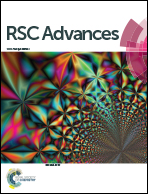Colorimetric and optical discrimination of halides by a simple chemosensor†
Abstract
A thiophene-based tripodal copper(II) complex has been synthesized as a new colorimetric and optical chemosensor for naked-eye discrimination of halides in acetonitrile and an acetonitrile–water mixture. The binding interactions of the new receptor with several anions were analyzed by UV-Vis titrations, electrospray ionization mass spectrometric (ESI-MS) experiments and density functional theory (DFT) calculations. The results from UV-Vis titrations indicate that the coordinative unsaturated copper(II) complex strongly binds a halide at its vacant copper(II) centre via a metal–ligand bond forming a 1 : 1 complex, exhibiting binding affinities in the order of fluoride > chloride > bromide > iodide. The interactions of the receptor with halides were further confirmed by ESI-MS, showing a distinct signal corresponding to a 1 : 1 complex for each halide, suggesting that the noncovalent interactions also exist in the gas phase. In addition, time-dependent DFT (TD-DFT) calculations were also carried out to understand the excited-state properties of the chemosensor complexes. A detailed analysis of the TD-DFT calculations shows a consistent red-shift in the first optically-allowed transition, consistent with the observed colorimetric experiments.


 Please wait while we load your content...
Please wait while we load your content...